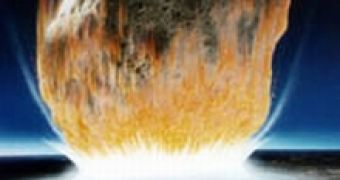On Sept. 3, 2004, the space-based infrared sensors of the U.S. Department of Defense detected an asteroid a little less than 10 meters across, at an altitude of 75 kilometers, descending off the coast of Antarctica. U.S. Department of Energy visible-light sensors built by Sandia National Laboratories, a National Nuclear Security Administration lab, also detected the intruder when it became a fireball at approximately 56 kilometers above Earth. Five infrasound stations, built to detect nuclear explosions anywhere in the world, registered acoustic waves from the speeding asteroid that were analyzed by LANL researcher Doug ReVelle. NASA's multispectral polar orbiting sensor then picked up the debris cloud formed by the disintegrating space rock.
In a study to be published this week in the journal Nature, scientists from the Australian Antarctic Division, the University of Western Ontario, the Aerospace Corporation, and Sandia and Los Alamos national laboratories found evidence that dust from the asteroid burning up as it descended through Earth's atmosphere formed a cloud of micron-sized particles significant enough to influence local weather in Antarctica.
Micron-sized particles are big enough to reflect sunlight, cause local cooling, and play a major role in cloud formation, the Nature brief observes.
"Our observations suggest that [meteors exploding] in Earth's atmosphere could play a more important role in climate than previously recognized," the researchers write.
Scientists had formerly paid little attention to asteroid dust, assuming that the burnt matter disintegrated into nanometer-sized particles that did not affect Earth's environment. Some researchers (and science fiction writers) were more interested in the damage that could be caused by the intact portion of a large asteroid striking Earth.
But the size of an asteroid entering Earth's atmosphere is significantly reduced by the fireball caused by the friction of its passage. The mass turned to dust may be as much as 90 to 99 percent of the original asteroid. Where does this dust go?
Some 7.5 hours after the initial observation, a cloud of anomalous material was detected in the upper stratosphere over Davis Station in Antarctica by ground-based lidar.
"We noticed something unusual in the data," says Andrew Klekociuk, a research scientist at the Australian Antarctic division. "We'd never seen anything like this before - [a cloud that] sits vertically and things blow through it. It had a wispy nature, with thin layers separated by a few kilometers. Clouds are more consistent and last longer. This one blew through in about an hour."
The cloud was too high for ordinary water-bearing clouds (32 kilometers instead of 20 km ) and too warm to consist of known manmade pollutants (55 degrees warmer than the highest expected frost point of human-released solid cloud constituents ). It could have been dust from a solid rocket launch, but the asteroid's descent and the progress of its resultant cloud had been too well observed and charted; the pedigree, so to speak, of the cloud was clear.
Computer simulations agreed with sensor data that the particles' mass, shape, and behavior identified them as meteorite constituents roughly 10 to 20 microns in size.
Says Dee Pack of Aerospace Corporation, "This asteroid deposited 1,000 metric tons in the stratosphere in a few seconds, a sizable perturbation." Every year, he says, 50 to 60 meter-sized asteroids hit Earth.

 14 DAY TRIAL //
14 DAY TRIAL //